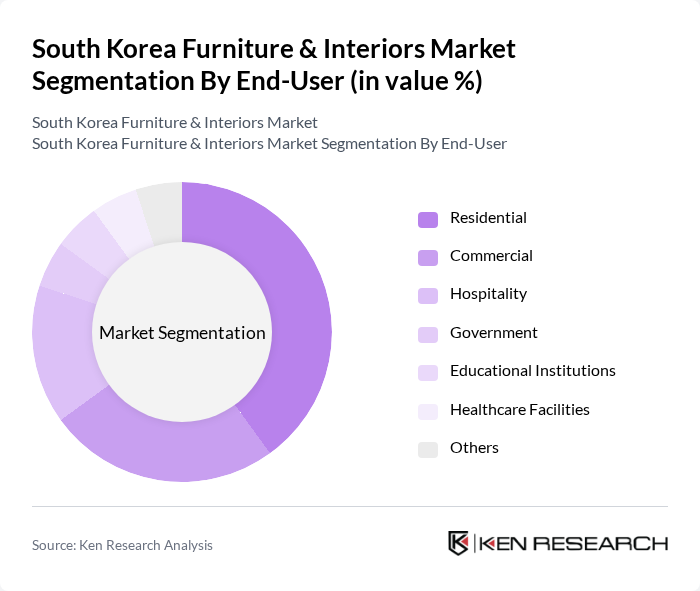Region:Asia
Author(s):Shubham
Product Code:KRAA3617
Pages:93
Published On:September 2025

By Type:The market is segmented into various types of furniture, including Residential Furniture, Office Furniture, Outdoor Furniture, Custom Furniture, Eco-Friendly Furniture, Luxury Furniture, Smart Furniture, and Others. Among these, Residential Furniture is the most dominant segment, driven by the increasing trend of home renovations and the growing interest in interior design. Consumers are increasingly investing in quality and aesthetic appeal, leading to a rise in demand for stylish and functional residential furniture. The smart furniture segment is also gaining traction due to its integration of technology and innovative features.

By End-User:The end-user segmentation includes Residential, Commercial, Hospitality, Government, Educational Institutions, Healthcare Facilities, and Others. The Residential segment leads the market, fueled by the increasing number of households and the trend towards personalized living spaces. Consumers are prioritizing comfort and aesthetics in their homes, which drives the demand for various types of furniture tailored to individual preferences.

The South Korea Furniture & Interiors Market is characterized by a dynamic mix of regional and international players. Leading participants such as Hanssem Co., Ltd., Livart Furniture Co., Ltd., Fursys Inc., Hyundai Livart, Kwangdong Furniture, Ace Bed Co., Ltd., Hyundai L&C, Samick Furniture Co., Ltd., Enex Co., Ltd., Casamia Co., Ltd., IKEA Korea, Shinsegae Casa, Fursys Group, Dongbu Corporation, KCC Corporation contribute to innovation, geographic expansion, and service delivery in this space.
The South Korea furniture market is poised for transformative growth, driven by technological advancements and evolving consumer preferences. As smart furniture gains traction, integrating technology into design will become essential, enhancing user experience. Additionally, the focus on sustainability will likely lead to increased demand for eco-friendly materials and practices. Companies that adapt to these trends and invest in innovative solutions will be well-positioned to capture emerging market opportunities and drive future growth.
| Segment | Sub-Segments |
|---|---|
| By Type | Residential Furniture Office Furniture Outdoor Furniture Custom Furniture Eco-Friendly Furniture Luxury Furniture Smart Furniture Others |
| By End-User | Residential Commercial Hospitality Government Educational Institutions Healthcare Facilities Others |
| By Distribution Channel | Online Retail Offline Retail Direct Sales Wholesale Interior Design Studios Others |
| By Material | Wood Metal Plastic Fabric Glass Composite Materials Others |
| By Price Range | Budget Mid-Range Premium Luxury Others |
| By Design Style | Modern Traditional Contemporary Rustic Industrial Korean Minimalist Others |
| By Functionality | Multi-Functional Space-Saving Ergonomic Modular Smart/Connected Others |
| Scope Item/Segment | Sample Size | Target Respondent Profiles |
|---|---|---|
| Residential Furniture Purchases | 120 | Homeowners, Interior Designers |
| Commercial Furniture Solutions | 100 | Office Managers, Facility Coordinators |
| Custom Furniture Design Trends | 80 | Architects, Custom Furniture Makers |
| Online Furniture Shopping Behavior | 120 | eCommerce Managers, Digital Marketing Specialists |
| Sustainability in Furniture Manufacturing | 80 | Sustainability Officers, Product Development Managers |
The South Korea Furniture & Interiors Market is valued at approximately USD 12.6 billion. This valuation reflects the growing demand for both residential and commercial furniture, driven by urbanization, rising disposable incomes, and a trend towards home improvement and interior design.